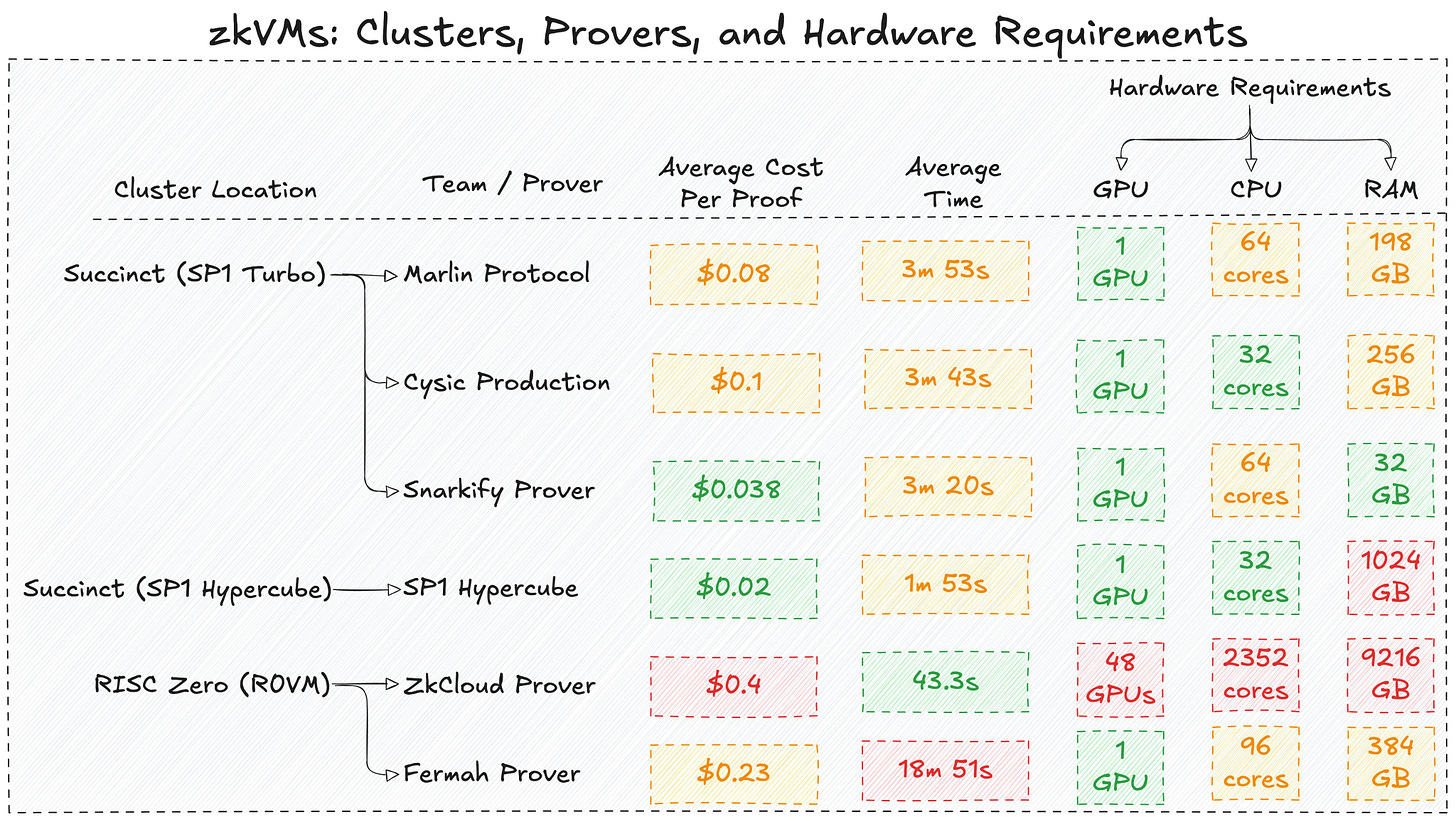Proof Generation on Succinct and RISC Zero
Comparison between SP1 Turbo (Succinct), SP1 Hypercube (Succinct), R0VM (RISC Zero).
TL;DR
SP1 Turbo: adoption + cost efficiency.
SP1 Hypercube: next-gen cost leader.
R0VM: smaller proofs + quantum safety, but more expensive.
Most people view proof generation as some kind of dark forest and rarely see any differences between different zk projects. However, key questions that we should answer are:
how much does it cost?
how much time does it take? • what are hardware requirements?
what are the proof sizes?
what are the next steps for proof generation?
1. zkVMs are competing with each others.
We will take 3 core zkVMs (virtual machines that can create zk proofs):
SP1 Turbo (by Succinct)
SP1 Hypercube (by Succinct)
R0VM (by RISC Zero)
Let’s take a look at high level overview at the moment:
Looking at the sheet, we can already define multiple interesting outcomes:
ISA stands for Instruction Set Architecture, every zkVM is using the same RISC-V (not to be confused with RISC Zero, that’s different).
Every zkVM has the same verification time a.k.a. time needed to verify the proof.
Every system has small amount of active clusters.
However, proof sizes for Succinct zkVMs are 3x larger than what RISC Zero generates.
What does the proof size mean? Well, it actually means how much proof takes data. Larger proofs are not necessarily more difficult to generate, but it enquires higher costs to do so. Proofs by R0VM are lighter (smaller) and they’re more efficient for L1 verification. However, it wouldn’t be that obvious without more data backed to it.
Let’s take a look at the sheet that outlines what does it take to generate a proof (within different clusters).
2. What it takes to generate some proofs?
Here the situation varies a lot from prover to prover.
ZkCloud can be considered as a prover for rich people. It is obviously the fastest (only 43.3s), however you have to be rich to afford it.
ZkCloud has the highest cost per proof: $0.4 on average (20x more than SP1 Hypercube).
You need 48 GPUs with 1152 GB of VRAM (most modern PC builds have around 8-16 GB of VRAM).
You need 2352 CPU cores (most modern CPUs have around 6-8 cores).
You need 9216 GB of RAM (most modern PC builds have around 16-64 GB of RAM).
But, you get the fastest proving time for most spent money. With Marlin Protocol, Cysic, and Snarkify - it’s different.
You still need to use really good hardware (because proof generation is complex process), but it’s significantly less compared to ZkCloud.
All 3 provers have similar proof generation time and simlilar costs to do so, however, Snarkify required less hardware, generates proofs faster for cheaper price.
Hypercube is current leading the field in price to quality ratio.
It’s the cheapest way to generate proofs (only 2 cents).
You only need 1 GPU and 32 cores CPU.
The only downside is that you need 1 TB of RAM. Hypercube generates proof twice as fast as provers from SP1 Turbo Cluster while it costs significantly less.
Fermah is currently showing the worst time with almost 19 minutes.
3. Direct comparison (Succinct vs. RISC Zero)
We can confidently say that Succinct’s zkVM has broader ecosystem traction (at present). 4 out of 10 clusters are using Succinct according to ethproofs.org.
SP1 Turbo is the workhorse: most widely deployed, open source, dual license, with 3 active clusters. Proofs take ~3–4 minutes and cost ~$0.04–0.10.
SP1 Hypercube is the newer generation. It delivers significant gains: proofs as low as $0.02 and ~2 minutes latency. However, it’s closed source and only 1 cluster is active.
R0VM shines in proof size and quantum resistance. ZkCloud’s cluster can deliver sub-minute proofs, but at very high infra costs.
Succinct is used in: Katana, Celestia (Blobstream), Sophon, Plume Network, +15 more, mainly seen across new zk infrastructure and L2 ecosystems with a TVS (Total Value Secured) of : $3.14B (6.62%).
RISC Zero is used in: Bob Network and Taiko Alethia, there are fewer integrations but R0 is particularly strong in Ethereum zk rollup ecosystem with TVS of: $239M (3.57%).






As a non-technical I really enjoyed this, thanks!!